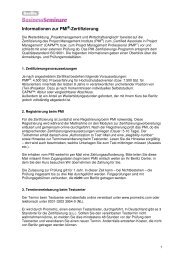Culture and the Customer Service Experience - Berlitz
Culture and the Customer Service Experience - Berlitz
Culture and the Customer Service Experience - Berlitz
You also want an ePaper? Increase the reach of your titles
YUMPU automatically turns print PDFs into web optimized ePapers that Google loves.
“ The most satisfied customers<br />
go out of <strong>the</strong>ir way to<br />
actively try to convince<br />
o<strong>the</strong>rs to do business<br />
with you. Unfortunately,<br />
dissatisfied customers<br />
make it a point to tell<br />
o<strong>the</strong>rs to stay away, <strong>and</strong><br />
dissatisfied customers are<br />
significantly more vocal.”<br />
JD Power <strong>and</strong> Associates<br />
• Time orientation: how long is a pause? Is it 3 seconds or 3 minutes?<br />
<strong>Berlitz</strong> Cultural Insights Series<br />
Research shows that pauses in 10 or 30 second intervals are acceptable in<br />
Eastern Europe. In some Asian cultures pauses lasting up to 1 minute are not<br />
unusual. In <strong>the</strong> Americas a pause that extends beyond 3.5 seconds is painful<br />
<strong>and</strong> Americans try to fill that void with a conversation even if it is “chit chat”.<br />
<strong>Culture</strong>s who are used to a longer pause may think this is a sign of disrespect<br />
or find it unusual to carry on a conversation outside <strong>the</strong> transaction itself.<br />
In <strong>the</strong> U.S., if a customer service representative is on <strong>the</strong> phone <strong>and</strong> needs to<br />
put a customer on hold, it is recommended <strong>the</strong>y tell <strong>the</strong> customer <strong>the</strong>y need to<br />
put <strong>the</strong>m on hold <strong>and</strong> ask if that is okay. In Eastern Europe, a much more<br />
transactional culture, representatives typically don’t ask permission.<br />
Asians on <strong>the</strong> o<strong>the</strong>r h<strong>and</strong>, apologize for putting a customer on hold, but don’t<br />
ask if that is okay.<br />
Underst<strong>and</strong>ing <strong>the</strong> time orientation of <strong>the</strong> culture is important.<br />
• Relationship vs. task orientation: Get it done, with or without a smile.<br />
In <strong>the</strong> United States, a customer service representative may appear to be <strong>the</strong><br />
customer’s “best friend” for five minutes. While <strong>the</strong>y are moving towards<br />
accomplishing <strong>the</strong> service task, <strong>the</strong>y are expected to appear personable<br />
<strong>and</strong> friendly.<br />
This approach is seen by many Eastern Europeans as ingenuine.<br />
In Asia, a slight, polite smile is expected, but Asians would not expect <strong>the</strong><br />
representative to act like <strong>the</strong>y are <strong>the</strong> customer’s best friend.<br />
• Achievement/optimism vs. Being/realism: What does “success”<br />
mean to your customers?<br />
In some cultures providing a business service to a customer is seen as an<br />
extension of <strong>the</strong> customer’s business—a “if you succeed we succeed mentality”.<br />
There is a “can do” attitude that is expected; let’s work as a team <strong>and</strong> solve<br />
it toge<strong>the</strong>r—as partners. <strong>Service</strong> representatives are expected to feel connected<br />
to <strong>the</strong> achievement of solving a problem.<br />
In Europe, where <strong>the</strong>re is a more “realistic” approach, customer service<br />
representatives expect to help solve <strong>the</strong> problem <strong>and</strong> move on. In cultures<br />
where <strong>the</strong>re is more “realism” representatives simply ask you about your problem<br />
<strong>and</strong> tell you “here is what you need to do to solve your problem”.<br />
In Asia, representatives show strong personal responsibility for a customer’s<br />
problem <strong>and</strong> would not expect <strong>the</strong> customer to be part of <strong>the</strong> resolution.<br />
• Formality vs. Friendliness: From “Yes, sir” to “How’s it going?”<br />
The level of formality vs. friendliness varies from country to country <strong>and</strong> culture<br />
to culture. For example:<br />
n In <strong>the</strong> U.S., it is not unusual for a customer service representative or sales<br />
person in a store to ask “How are you? Are you finding everything ok?<br />
Or “Did you find what you were looking for?”<br />
<strong>Culture</strong> <strong>and</strong> <strong>the</strong> <strong>Customer</strong> <strong>Service</strong> <strong>Experience</strong> 5
















